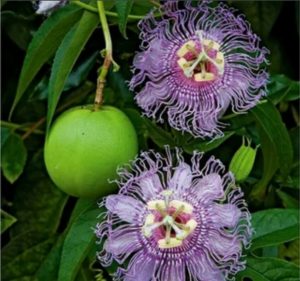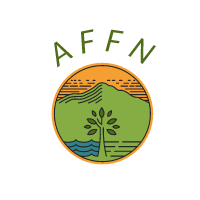The Orchard
Where you can find us:
Our website address is: https://www.affnorchard.org.
Our orchard is located on CR804 in Etowah Tennessee, across the street from Coghill Baptist Church.

Native Fruit Trees
Pawpaws
This is the least known of America’s native fruits, and ironically it is also North America’s largest, and many would say most flavorful, fruit. It is native from southern Ontario to northern Florida and as far west as Missouri, Arkansas and Texas. (In fact, the town name “Natchitoches” means pawpaw in the Native American language once spoken in Texas and Louisiana.)
Tennessee is literally in the very heart of its range, and it is very popular in the Ohio River Valley States of West Virginia, Ohio and Indiana. Lewis and Clark mention eating them frequently. “One can live well on pawpaws.” For the Native Americans, pawpaw was a seasonal treat because it was perishable, but much loved it is thought, as wherever the Native Americans lived, they transported and planted pawpaw seeds, leading to isolated patches of pawpaws outside their normal range.
The species name of pawpaw is Asimina, a Native American word “asimina” or “simina” from the Creek language. And the word pawpaw is related to the Caribbean native word papaya, a fruit with which pawpaw is often confused, though they are unrelated, and taste and look completely different.
Unlike more commercially available fruits like apples, pears, and plums, pawpaws have resisted modern market cultivation, some say because of their purported short shelf life and tendency to bruise. At room temperature, their shelf life is measured in days, but with refrigeration the shelf life is extended to 4 weeks, or so.
Selections at the Orchard include selected wild pawpaws, and 1st and 2nd generation improved cultivars from Jerry Lehmann, James Claypool, the Kansas State University breeding program and Neal Peterson. These brief efforts to develop the fruit show enormous potential for the fruit commercially. We, however, like the amazing wild variability of the fruit.
| AFFN Pawpaw Cultivars | ||
|---|---|---|
| 275-48 | Nyomi’s Delight | Taytoo (Taytwo) |
| 9-58 | Potomac (Petersen) | Wabash (Petersen) |
| Allegheny (Petersen) | Rebecca’s Gold | Wells |
| Prima 1216 | SAA Overleese | |
| Jerry’s Big Girl (250-39, JBG) | Seedling (250-30×250-39) | |
| KSU Atwood | Seedling (250-39xOP) | |
| KSU Benson | Seedling (275-56xOP) | |
| KSU Chappell |
Shenandoah (Petersen) |
|
| Lehman’s Delight | Summer Delight | |
| Mango | Sunflower | |
| Maria’s Joy | Susquehanna (Petersen) | |
| NC-1 (Campbell’s No. 1) | Tallahatchie (Petersen) | |
| Over 30 additional varieties are in graft for 2023/2024. For the full list, go to our Pawpaw Page. |
|
What to do with Pawpaws?
American Persimmons
The American persimmon (Diospyros virginiana) was a staple of Native American diets, but it is much misunderstood by modern Americans, who mainly know them as mouth puckering and distasteful. And if they are picked before peak, soft ripeness, they are indeed an unforgettable shock, being very dry and unpleasant to taste. This repels critters, too, though, who also dislike the astringency in the unripe fruit.
The word persimmon itself is an Anglicism of the Native American word “putcheman” from the Algonquin language. This is also the origina of the word “possum”, and to this day sometimes persimmon goes by the name “possum wood”. Possums do indeed love the fruit when it is ripe and sometimes can be found in the boughs of the trees, and maybe that is the natural historical connection in these two words, possum and persimmon.
The American persimmons grown at the Orchard range from forest selected varieties to first- and second-generation crosses of these selections from the breeding efforts of James Claypool, Jerry Lehmann, John Hershey, Donald E. Compton, and Clifford England. (A special thanks to Cliff for his generous sharing of knowledge.)
| AFFN Cultivars | ||
|---|---|---|
| Lehmann (100-42) | Killen | Szukis |
| Celebrity (U-20A) |
Lehman’s Delight (100-46) |
Tatum (deer predation…) |
| Deer Magnet | Meader | Valeen Beauty (I-94) |
| Early Jewell (H-118) | Mohler | Weber |
| Elmo (A-118) | Morris Burton | Wonderful |
| Garretson | Prairie Dawn (H-55A) | Yates (Juhl) |
| Claypool (H-63A) | Prairie Gem (F-25) | John Rick |
| I-115 | Prairie Sun (A-33) | Ruby |
| Claypool (J-59) | Prok | Barbara’s Blush (WS8-10) |
| 45 additional varieties are in graft for 2023/2024. For the full list, go to our Persimmon Page. | ||
What to do with Persimmons?
Homestead Fruit Trees
Appalachia has a long history of settlers “making a go of it” in marginal conditions – hilly plots, rocky soil, pressure from woodland creatures and vermin (critters and varmits!). Many times, the settlers were the Poor, who could not find a place in the rich fertile plantation lands east and south of the Appalachian Mountains. One finds their plants sometimes as the sole remnant of homesteads that formerly dotted the landscape and hollows (“hollers and coves”) of the region. What they chose were plants tolerating poor soil, fluctuations in rainfall, and most of all resisting, browsing by deer.
Asian Persimmons
These truly bountiful trees come to us from Asia – mainly Japan and China – where they have been cultivated for a couple thousand years. They produce the highest number of pounds of fruit per acre of any fruit grown by mankind. A single small (12′-15′) tree can produce 200-300 pounds of fruit!
Asian persimmons (Diospyros kaki) were introduced by Asian laborers who came to America in the mid-1800’s to help build America’s transcontinental railroads. Starting in the West, gradually Asian persimmons moved eastward, delighting people who made a place for them in their gardens with their sweetness, flavors of baking spices and butterscotch, their long shelf life, and of course the chance to share abundance with friends, neighbors and family. They can be picked ahead of their full ripeness and will ripen over weeks on the counter and even in the refrigerator. They can also be dried and make an almost candy-like fruit, even sweeter than dried apricots. The genus name “diospyros” means “food of the gods”, and Asian persimmons very rightly carry this genus name.
| AFFN Asian Persimmon Cultivars | ||
|---|---|---|
| Cardinal | Great Wall | Maekawa Jiro |
| Chinebuli | Gwang Yang | Nishimura Wase (Coffee Cake) |
| Fuyu | Hachiya | Raven |
| Giant Fuyu | Hanafuyu | Rojo Brilliante |
| Giombo | Ichi ke Jiro |
Saijo |
| Great Wall | Inchon | Sheng |
| Gwang Yang | Jin Young Tam Kam | Tanenashi |
| Jiro | ||
| Over 30 additional varieties are in graft to be added in 2023/2024. For the full list, go to our Persimmon Page. | ||
American-Asian Persimmon Hybrids
Some of the most interesting fruits in the persimmon family are the American-Asian hybrids, which go botanically by the designation Diospyros hybrid. Work was begun at least as early as the 1950’s in the then Soviet Union, out of the specimen collections of Michurin, at the Nikitsky Botanical Garden in Yalta in Crimea. Michurin was a founder of modern agricultural plant selection, and he would often cross geographically distant cultivars to create agriculturally improved cultivars, targeting traits like frost tolerance, yield, and disease resistance. The goal in crossing American persimmons, with their pronounced flavor, aroma, and cold-hardiness, with Asian persimmons, with their fruit size and thicker skin, was to find a more cold-hardy, yet pleasant tasting, persimmon.
One of the first Asian-American hybrid persimmon cultivars, “Rosseyanka”, was introduced in 1964. The name of the gardens and some of the scientists lives on in the names of some of the hybrid’s such as “Nikitski Bordovaya” (Nikita’s Gift), and “Dr. Kazas Hybrid”. This work has continued in the US in the work of American horticulturists. The AFFN orchard is proud to be home to several of these varieties. We are always on the lookout for more. Hybrids are an effort to combine and express the best of two worlds! Also, if anyone has records or information related to the crossbreeding efforts in Yalta and subsequent efforts, please reach out to share this with us. Much of this knowledge is imperiled by the tragic conflict in Ukraine and Crimea, and we can do our part to preserve the knowledge from these breeding efforts and these cultivars.
| American-Asian Persimmon Cultivars | ||
|---|---|---|
| David’s Kandy | Nikita’s Gift (NB-01) | |
| Journey | Russian Beauty (Rosseyanka) | |
| Kasandra | Saijo x Rosseyanka | |
| 9 additional varieties are in graft for 2023/2024. For the full list, go to our Persimmon Page. |
Figs
Figs are another surprise in Appalachia. One hears over and over the surprised exclamation “Those grow around here?!” Yes, and they grow very well!
The plants and the immature fruit magnificently resist pressure from birds and browsing deer. The unripe fruit and the leaves are filled with a bitter, latex-rubber compound (much like milk weed). But this disappears as the fruit ripens. Fruit can be picked a day ahead of peak ripeness and left to ripen overnight on the counter, and then refrigerated (if kept dry) for the next couple of weeks.
Pomegranates
Yes – one finds pomegranate trees near old Appalachian homesteads! Who knew?! One does hear of them here and there at old home sites in the Smokey Mountains. So, the fruit has been grown in these parts for over a hundred and fifty years.
The AFFN Orchard grows selections developed in the Russian selection program started in the 1970s to find flavorful and cold resistant cultivars. We would very much like to add to our collection samples from some of the old home sites in Appalachia. Volunteers are encouraged to bring them to us.
Native Berries
Maypops
Known to the Cherokee as “Ocoee” an entire river valley is named after this edible native plant, presumably for its beauty and flavor. It is also the lesser-known Tennessee State Wildflower, designated as such in 1919 by Tennessee Senate Joint Resolution 13. (The State’s “garden flower” is the more commonly known Bearded Iris.)

Chokeberries (a.k.a. thank goodness as “Aronia”)
Obviously, this is a berry with a marketing problem…Who would eat a chokeberry? Luckily, they also go by the more appetizing name Aronia berry. And although they are from Appalachia, they have been almost entirely forgotten, except by the deer. At AFFN, we are pretty sure this is their absolute favorite bush…
Forgotten in Appalachia, it is studied in…Iowa (?!). And the country exporting 90% of the world’s Aronia products is not even the USA. It is…Poland (?!). Bravo to the Poles for having recognized this berry’s amazing antioxidant properties and fine flavor!
We are trying to grow and re-popularize this fruit, if we can save some from the deer…Some varieties that we have on hand: MacKenzie, Viking, Nero, PI 662003, AMES 34423 and AMES 30007 (These last two come to us from the USDA GRIN program, whose valuable work makes germplasm available to growers like AFFN! These germplasms would not be available or preserved without the work of the USDA-ARS Germplasm Resources Information Network which is through the U.S. National Plant Germplasm System. ) An interesting fact about Viking and Nero is that they have come back to North America from hybridizing in Europe with European Mountain Ash, much like the hybridized Asain-American persimmons. These hybrids bring something of the best of two worlds.
Huckleberries
This is an oft-misidentified fruit. A couple of different genera comprise the fruits known as “huckleberries”, and they fall into a western group, in the genus vaccinium, and an Eastern group in the genus Gaylussacia. They are often confused with blueberries, which also happen to fall into the genus vaccinium.
But huckleberries do have a brighter flavor than blueberries, much like wild strawberries have a brighter flavor than their commercial counterparts. Gaylussacia are also seedier than vaccinium, having ten seeds per berry rather than five, and the seeds tend to be crunchier. Vaccinium prefers rather acidic soils whereas Gaylussacia is less dependent on this soil feature, better suited for our less acidic Appalachian soils.
At the orchard, we are attempting to establish a few Western varieties, the common huckleberry, vaccinium membraneceum and the evergreen huckleberry, vaccinium ovatum, and, the Bilberry or Whortleberry, vaccinum myrtillus. But we would like to focus more on the lesser-known Eastern varieties, known to our forebears. Gaylussacia bacata, brachycera, frondosa, dumosa, hirtosa…
Volunteers are encouraged to bring cuttings from their favorite Eastern huckleberry patches. AFFN has sprouted some of these from seed. But the sprouts grow very slowly. In their first season after spouting, most will still be smaller than a grain of rice! So rooted cuttings may be more practical.
Edible Honeysuckle
Honeyberries or Haskaps (from Japanese native Aino language “hassukappu”) grow all around the northern hemisphere spanning Siberia, the Japanese islands, boreal Canada all the way down to Mexico. It has a phenomenal geographic range and is becoming more popular as a cultivated fruit plant. Many wild varieties are astringent and tart, leading them to have been mostly used for medicinal purposes, or admixed with more flavorful berries. But selections from the wild, and 1st and 2nd generation crossings, have resulted in remarkably sweet and flavorful cultivars. We are giving them a try to see if they can become a new homestead favorite.
Currants
The currants at the orchard are native varieties to North America but taken from from further west: the common Clove Currant (ribes odoratum), the Missouri Giant Currant (ribes odoratum var. villosum), the Golden Currant (ribes aureum), Crandall Currant (ribes odoratum “Crandall”) and we have recently received seeds from “Gwen’s Buffalo Currant” (ribes odoratum “Gwen”). These were also provided to us by USDA’s GRIN germplasm program. The fragrance of the flowers in the springtime is lovely, with their strong clove scent. And so it garnered the mellifluous name, “odoratum”…
The berries are juicy and tart and have something of the clove aroma. What they lack is the muskiness or earthiness of European blackcurrants, a flavor that some North American palates consider to be an “acquired taste”. To maximize the sweetness, these bushes need full sun, and bird netting, so that the berries ripen before the birds make off with them.
Elderberries
Last but not least – Elderberries! We have several cultivars of them – Bob Gordon, Marge, York, Nova, Variegated…We love them for their fragrant blooms from which delicious, floral syrup is derived. Boil the blossoms in simple syrup briefly for this fragrant treat. And we prize them for their berries. Also, boiling the berries for just a few minutes in simple syrup draws out a delicious blueberry/grape flavor.
Nut Trees
We will have more information on nut trees once they are better established at the orchard.
Pecan (nine cultivars, a mix of Type I and Type II with overlapping bloom patterns, for cross-pollination)
North American Beaked Hazelnut
Chestnut Hybrids (minimum 7/8 American Chestnut)
Hickory
Hican
European Hazelnut (six cultivars)
Heartnut (aka Japanese Walnut)
